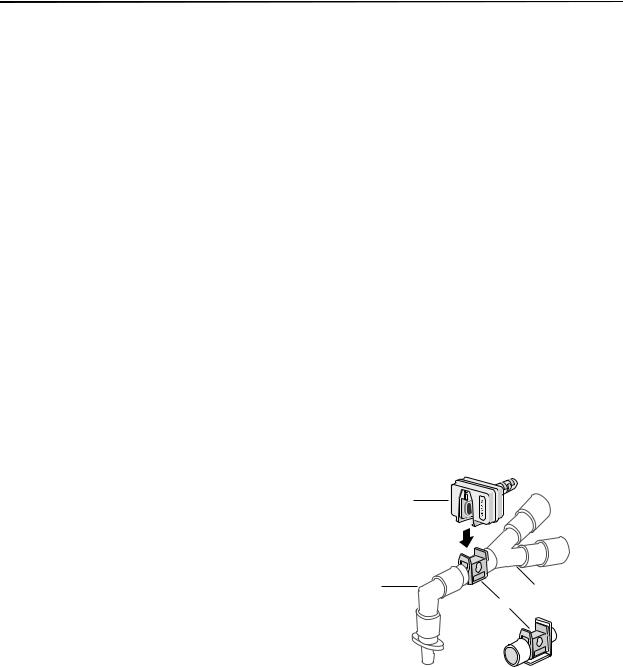ZOLL M Series User Manual

End Tidal Carbon
Dioxide (EtCO2)
TM
9650-0223-01 Rev. D
The issue date or revision level for this operation guide is shown on the front cover.
ZOLL is a registered trademark, and M Series is a trademark of ZOLL Medical Corporation. CAPNOSTAT is a registered trademark and LoFlo is a trademark of Respironics Novametrix LLC. Cidex is a registered trademark of Advanced Sterilization Products, a Johnson and Johnson Company. Nafion is a registered trademark of DuPont.
System 1 is a registered trademark of the Steris Corporation.
©2005 by ZOLL Medical Corporation. All rights reserved.
END-TIDAL CARBON DIOXIDE (EtCO2)
General Information
Product Description
M Series™ units, equipped with software revision 38.25 or higher, and M Series CCT units, equipped with software revision 57.50 or higher, support two End Tidal Carbon Dioxide (EtCO2) monitoring options for the continuous measurement of respiratory carbon dioxide (CO2) and respiration rate. These options use the same connector on the M Series unit and may be used interchangeably.
The first option uses a unique mainstream, solid-state infrared sensor called the CAPNOSTAT® 3 Mainstream CO2 sensor. The CAPNOSTAT 3 sensor is attached to an airway adapter that connects to an endotracheal (ET) tube or other airway and measures gases flowing through these breathing circuit components. A disposable mouthpiece may be connected to the adapter for monitoring non-intubated patients. A Capno2mask is also available for use with nonintubated patients. This option provides for O2 delivery while monitoring expired CO2.
The second option is a sidestream sampling system called the LoFlo™ Sidestream CO2 Module. The LoFlo module contains a gas sampling pump, which draws small samples of gas from the patient’s airway via a nasal/oral cannula or airway adapter, and passes these gases through a solid state infrared sensor (located away from the patient’s airway) that measures CO2. While the sidestream system is typically used on non-intubated patients, it can also be used for EtCO2 measurement on intubated infant, pediatric, and adult patients. The sidestream system should not be used, however, on intubated patients who cannot tolerate the 50ml/min removal of the sample gases from their breathing circuit. The sidestream module uses specially designed sampling cannulae and airway adapters for sampling airway gases and passing them through an integrated sample cell, which connects to the LoFlo Module’s CO2 sensor. These cannulae incorporate a filter and sample cell, providing maximum filtration of fluids and contaminants, and protecting the system from aspiration of these fluids.
In both systems, the CO2 sensor generates infrared light and beams it through the airway adapter or sample cell to a detector on the opposite side. CO2 from the patient, flowing through the mainstream airway adapter or aspirated into the sample cell, absorbs some of this infrared energy. The M Series unit determines CO2 concentration in the breathing gases by measuring the amount of light absorbed by gases flowing through the airway or sample cell.
The M Series unit displays EtCO2 (the concentration of carbon dioxide detected at the end of each exhalation) as a numerical value in millimeters of mercury (mmHg), percent (%), or kilopascals (kPa). In addition, the unit can display a capnogram waveform. This waveform is a valuable clinical tool that can be used to assess patient airway integrity and proper endotracheal (ET) tube placement. The unit calculates respiration rate by measuring the time interval between detected peaks of the CO2 waveform. The technology differentiates between waveforms caused by breathing and those caused by cardiogenic oscillations and artifact.
How to Use This Manual
This section explains how to set up and use the M Series End-Tidal Carbon Dioxide option. Important safety information relating to general use of the M Series End Tidal Carbon Dioxide monitor appears in the “Safety Considerations” section of this manual.
The M Series Operator’s Guide provides information operators need for the safe and effective use and care of the
M Series unit. It is important that persons using this device read and understand all the information contained therein. Please thoroughly read both safety considerations and warnings sections before operating your M Series unit.
All CAPNOSTAT 3, LoFlo, airway adapter and cannula questions with regards to the Declaration of Conformity with European Union Directives should be directed to the authorized representative for Respironics Novametrix LLC:
Respironics Novametrix LLC
Authorized European Contact
Respironics Deutschland
Gewerbestrasse 17
82211 Herrsching
Germany +49 8152 93060
EtCO2 - 1

Safety Considerations
WARNINGS
General
•Carefully read the M Series Operator’s Guide and these operating instructions before operating the EtCO2 monitoring option.
•Ensure that the M Series EtCO2 option is operated by qualified personnel only.
•Do NOT use the M Series EtCO2 option as an apnea monitor.
•Do NOT immerse the M Series unit, patient cables or sensors in water, solvents, or cleaning solutions.
•If the accuracy of any reading is suspect, first check the patient’s vial signs by alternate means and then
check the M Series EtCO2 option for proper operation.
•If an alarm condition occurs while the alarms are suspended, the suspended alarm indications will only be visual displays and symbols. No audio alarm indications will occur.
•To ensure patient safety, ensure that the ECG-out jack and modem (if available) are only connected to other equipment with galvanically isolated circuits.
•Elevated oxygen levels, nitrous oxide or halogenated agents contained in the breathing gases may degrade the accuracy of measurements made with
the M Series EtCO2 option. Activate oxygen compensation if O2 levels in excess of 60% are introduced. Activate N2O compensation if nitrous oxide is introduced into the airway circuit. The presence of Desflurane beyond 5% may positively bias the carbon dioxide reading by up to 3 mmHg.
•Do NOT use the LoFlo module on patients who cannot tolerate the removal of 50ml/min from the airway.
•Carefully route patient cabling and gas sampling tubes to reduce the possibility of patient entanglement or strangulation.
•Do not touch the bed, patient, or any equipment connected to the patient during defibrillation. A severe shock can result. Do not allow exposed portions of the patient’s body to come in contact with metal objects, such as a bed frame, as unwanted pathways for defibrillation current may result.
CAPNOSTAT 3 and LoFlo Sensor and Accessories
•Always ensure the integrity of the patient breathing circuit after insertion of the mainstream or
sidestream airway adapter by verifying a proper CO2 waveform (capnogram) on the monitor display.
•Do NOT use CAPNOSTAT 3 or LoFlo sensors in the presence of flammable anesthetics or other flammable gases.
•Do not attempt to open the sensor. An electrical shock hazard exists internally. Refer servicing to qualified personnel.
EtCO2 - 2

End Tidal Carbon Dioxide (EtCO2)
CAUTIONS
•CAUTION: Federal (U.S.A.) law restricts this device to sale, or use by or on the order of a licensed medical practitioner.
•Use only ZOLL/Respironics Novametrix CAPNOSTAT 3 sensors and LoFlo modules, airway adapters, nasal and nasal/oral cannulae with the M Series EtCO2 option.
•The device is protected against interference from radio frequency emissions typical of two-way radios and cellular phones (digital and analog) used in emergency service/public safety activities. Users should assess the device’s performance in their typical environment of use for the possibility of radio frequency interference from high-power sources. Radio Frequency Interference (RFI) may be observed as shifts in monitor baseline, trace compression, display brightness changes or transient spikes on the display.
•Do NOT sterilize or immerse the CAPNOSTAT 3 sensor or LoFlo module.
•Do NOT reuse or sterilize the disposable airway adapter, airway adapter with mouthpiece, Capno2mask, nasal or nasal/oral sampling cannulae, or airway adapters, as system performance will be compromised. These items are intended for single patient use only.
•Do NOT use a damaged sensor or airway adapter.
•Do NOT use the device if it fails to operate properly.
•Do NOT place the mainstream or sidestream airway adapters between the ET tube and the breathing circuit elbow, as this may allow patient secretions to accumulate in the adapter.
•Position mainstream airway adapters with windows in a vertical, NOT a horizontal, position. This helps keep patient secretions from pooling on the windows.
•Do NOT insert any object other than the sample cell into the sample cell receptacle on the LoFlo module.
•ZOLL Medical Corporation recommends that the CAPNOSTAT 3 airway adapter be removed from the circuit whenever aerosolized medication is delivered. The increased viscosity of the medications may contaminate the adapter windows, requiring premature cleaning or replacement of the adapter.
•In order to eliminate the potential buildup of CO2 inside the storage bag, ensure that the LoFlo module exhaust tube vents gasses away from the module environment.
•To avoid injury to the patient, remove the nasal/oral cannula from the patient before cutting the oral cannula tip.
•Do NOT apply tension to the sensor or module cable.
•Periodically inspect the sampling tubing for kinks.
•Monitor the capnogram for an elevated baseline. If an elevated baseline is observed, verify patient condition first. If the care giver determines that the patient condition is not contributing to the elevated baseline, follow the instructions for zeroing the sensor or module detailed in this manual.
•Do NOT store sensors, modules, airway adapters, or cannulae at temperatures less than -10° C or greater than 55° C.
•Do not operate sensors or modules at temperatures less than 10° C or greater than 40° C.
•Refer servicing to qualified personnel.
•Do not use the LoFlo module with M Series units that have a software version lower than 38.25, or with M Series CCT units that have a software version lower than 57.50.
•Make sure to insert the protective cap into the LoFlo module when it is not in use.
EtCO2 - 3

M SERIES OPERATOR’S GUIDE - OPTION INSERT
Warranty (U.S. Only)
(a) ZOLL Medical Corporation warrants to the original equipment purchaser that beginning on the date of installation, or thirty (30) days after the date of shipment from ZOLL Medical Corporation's facility, whichever first occurs, the equipment (other than accessories and electrodes) will be free from defects in material and workmanship under normal use and service for the period of one (1) year. During such period ZOLL Medical Corporation will, at no charge to the customer, either repair or replace (at ZOLL Medical Corporation's sole option) any part of the equipment found by ZOLL Medical Corporation to be defective in material or workmanship. If ZOLL Medical Corporation's inspection detects no defects in material or workmanship, ZOLL Medical Corporation's regular service charges shall apply. (b) ZOLL Medical Corporation shall not be responsible for any equipment defect, the failure of the equipment to perform any function, or any other nonconformance of the equipment, caused by or attributable to: (i) any modification of the equipment by the customer, unless such modification is made with the prior written approval of ZOLL Medical Corporation; (ii) the use of the equipment with any associated or complementary equipment, (iii) installation or wiring of the equipment other than in accordance with ZOLL Medical Corporation's instructions, (iv) abuse, misuse, neglect or accident. (c) This warranty does not cover items subject to normal wear and burnout during use, including but not limited to lamps, fuses, batteries, patient cables and accessories. (d) The foregoing warranty constitutes the exclusive remedy of the customer and the exclusive liability of ZOLL Medical Corporation for any breach of any warranty related to the equipment supplied hereunder. (e) Limitation of Liability: ZOLL shall not in any event be liable to Purchaser, nor shall Purchaser recover, for special, incidental or consequential damages resulting from any breach of warranty, failure of essential purpose, or under any other legal theory including but not limited to lost profits, lost savings, downtime, goodwill, damage to or replacement of equipment and property, even if ZOLL has been advised of the possibility of such damages.
THE WARRANTY SET FORTH HEREIN IS EXCLUSIVE AND ZOLL MEDICAL CORPORATION EXPRESSLY DISCLAIMS ALL OTHER WARRANTIES WHETHER WRITTEN, ORAL, IMPLIED, OR STATUTORY, INCLUDING BUT NOT LIMITED TO ANY WARRANTIES OF MERCHANTABILITY OR FITNESS FOR A PARTICULAR PURPOSE.
For additional information, please call ZOLL Medical Corporation at 1-800-348-9011. International customers should call the nearest authorized ZOLL Medical Corporation service center.
Software License
Read this Operator's Manual and License agreement carefully before operating any of the M Series products.
Software incorporated into the system is protected by copyright laws and international copyright treaties as well as other intellectual property laws and treaties. This software is licensed, not sold. By taking delivery of and using this system, the Purchaser signifies agreement to and acceptance of the following terms and conditions:
1.Grant of License: In consideration of payment of the software license fee which is part of the price paid for this product ZOLL Medical Corporation grants the Purchaser a non-exclusive license, without right to sublicense, to use the system software in object-code form only.
2.Ownership of Software/Firmware: Title to, ownership of and all rights and interests in the system software and all copies thereof remain at all times vested in the manufacturer, and Licensors to ZOLL Medical Corporation and they do not pass to Purchaser.
3.Assignment: Purchaser agrees not to assign, sublicense or otherwise transfer or share its rights under the license without the express written permission of ZOLL Medical Corporation.
4.Use Restrictions: As the Purchaser, you may physically transfer the products from one location to another provided that the software/firmware is not copied. You may not disclose, publish, translate, release or distribute copies of the software/firmware to others. You may not modify, adapt, translate, reverse engineer, decompile, crosscompile, disassemble or create derivative works based on the software/firmware.
NO IMPLIED LICENSE
Possession or purchase of this device does not convey any express or implied license to use the device with replacement parts which would, alone, or in combination with this device, fall within the scope of one or more of the patents relating to this device.
EtCO2 - 4

EtCO2 Indications for Use
The ZOLL M Series EtCO2 option is indicated for the continuous noninvasive monitoring of end tidal carbon dioxide (EtCO2) and respiration rate in patients requiring ventilator support, transport, or anesthesia. The M Series EtCO2 option with Respironics Novametrix technology supports two methods for continuous measurement of end tidal carbon dioxide (EtCO2) and respiration rate.
The first method uses the CAPNOSTAT 3 Mainstream CO2 Sensor attached to an airway adapter that connects to an endotracheal tube, mask or disposable mouthpiece.
The second method uses the LoFlo Sidestream CO2 Module to monitor both non-intubated and intubated patients using specially designed sampling cannulae and airway adapters.
The M Series EtCO2 option is designed to monitor adult, pediatric, and neonatal patients.
The following substances can influence CO2 measurements made with the CAPNOSTAT 3 Sensor:
•elevated oxygen levels
•nitrous oxide
•halogenated agents
The M Series EtCO2 option allows the user to enable high oxygen and/or nitrous oxide compensation. Halogenated anesthetic agents alter CO2 readings, but the M Series unit will monitor CO2 within specifications when these agents are present at normal clinical levels. The presence of Desflurane in the exhaled breath beyond normal values (5-6%) may positively bias measured carbon dioxide values by up to an additional 2-3 mmHg.
The M Series EtCO2 option is intended for use only with the ZOLL/Respironics Novametrix CAPNOSTAT 3 Mainstream CO2 sensor and the LoFlo Sidestream CO2 Module, mainstream airway adapters, nasal and nasal/ oral sampling cannulae, and sidestream on-airway adapters.
Mainstream EtCO2 Setup
There are several steps involved with mainstream EtCO2 setup, as follows:
•Attaching the CAPNOSTAT 3 sensor cable.
•Selecting a mainstream airway adapter.
•Attaching the airway adapter to the CAPNOSTAT 3 sensor.
•Zeroing the mainstream sensor/airway adapter.
•Attaching the airway adapter to the airway circuit.
•Applying an airway adapter with mouthpiece.
End TIdal Carbon Dioxide (EtCO2)
Attaching the CAPNOSTAT 3 Sensor Cable
To attach the CAPNOSTAT 3 sensor cable, plug the cable into the CO2 connector at the back of the M Series unit.
Note Effective with M Series software revision 38.35 and M Series CCT software revision 57.50, the “0” and “REF” cells on the sensor cable are no longer used. However, they remain on the sensor cable for backwards compatibility with earlier versions of the software.
Selecting a Mainstream Airway Adapter
Select an airway adapter based on the patient's size, ET tube diameter and monitoring situation. For more information refer to the following table or contact ZOLL Medical Corporation.
Airway Adapter Type |
ET Tube Diameter |
|
|
SPU Pediatric/Adult |
> 4.0 mm |
|
|
Adult Reusable |
> 4.0 mm |
|
|
SPU Neonatal/Pediatric |
≤ 4.0 mm |
|
|
Neonatal Reusable |
≤ 4.0 mm |
|
|
*SPU = Single Patient Use
Attaching the Airway Adapter to the CAPNOSTAT 3 Sensor
Before attaching the airway adapter to the CAPNOSTAT 3 sensor, verify that the airway adapter windows are clean and dry. Clean or replace the adapter if necessary.
CAUTION! The disposable (SPU) Pediatric/Adult and the Neonatal/Pediatric airway adapters are intended for single patient use. Do NOT reuse or sterilize these adapters as system performance will be compromised.
1.Attach the airway adapter to the CAPNOSTAT 3 sensor, as follows:
a.Align the arrow on the bottom of the airway adapter with the arrow on the bottom of the CAPNOSTAT 3.
b.Press the sensor and airway adapter together until they click.
2.If the unit displays the “CHECK CO2 ADAPTER” message, follow steps a through c, or else go to step 3.
a.Verify proper connection of the adapter to the sensor.
b.Verify that the airway adapter windows are clean and dry.
EtCO2 - 5

M SERIES OPERATOR’S GUIDE - OPTION INSERT
c.If the adapter is properly connected, and the windows are clean and dry, then zero the adapter as described in the next section, "Zeroing the Mainstream Sensor/Airway Adapter".
3.Turn the Selector switch on the M Series unit to MONITOR (ON for AED units).
4.Wait for the airway adapter and sensor to warm up.
The unit will display a “WARM UP” message for approximately one minute while the sensor and adapter warm to operating temperature. The message disappears when the sensor is ready to use.
Note Warm-up time varies with ambient temperature of the sensor.
Zeroing the Mainstream Sensor/Airway Adapter
Adapter zeroing compensates for the optical differences between airway adapters and should be performed after switching between different airway adapter types, in order to obtain accurate readings.
Zeroing is also necessary the first time a particular CAPNOSTAT 3 sensor is connected to the unit.
The M Series unit retains the CAPNOSTAT 3 sensor's zero settings during and after its use. When a previously used sensor is reconnected to the M Series unit, sensor zeroing does not need to be repeated, as long as no other CAPNOSTAT 3 sensor or adapter type has been connected and zeroed during the interim period.
1.Place the sensor with the adapter installed away from
all sources of CO2 (including the patient's – and your own – exhaled breath and ventilator exhaust valves).
2.Press the Param. softkey and select the EtCO2 menu item, then press Enter.
3.Press the Zero softkey until the Start menu item is highlighted, then press Enter.
The unit zeroes the adapter and displays the "ZEROING CO2 ADAPTER" message for approximately 15 seconds.
The unit displays the message “ZERO DONE” upon completion of the zeroing.
Note Do not attempt zeroing for 20 seconds after removing the adapter from the patient’s airway. This time allows any CO2 remaining in the adapter to dissipate before zeroing. Do not attempt to zero the adapter while it is in the patient’s airway. Zeroing with CO2 in the adapter can lead to inaccurate measurement and/or other error conditions. If you attempt zeroing while CO2 remains in the adapter, the time required to zero the adapter may be increased. If zeroing cannot be completed, the message “ZERO FAILED” will be
displayed. If this occurs, clear any occlusion in the adapter, remove the source of CO2, wait 20 seconds, and try zeroing again.
Attaching the Airway Adapter to the Airway Circuit
If you have not yet done so, you must attach the airway adapter to the CAPNOSTAT 3 sensor before attaching the airway adapter to the airway circuit. Refer to "Attaching the Airway Adapter to the CAPNOSTAT 3 Sensor" on page 5 if necessary.
Attach the airway adapter to the airway circuit as follows:
1.Place the CAPNOSTAT 3/airway adapter assembly at the proximal end of the airway circuit between the elbow and the ventilator circuit wye. Do NOT place the airway adapter between the ET tube and the elbow, as this may allow patient secretions to accumulate in the adapter.
Position the airway adapter with its windows in a vertical, NOT a horizontal, position. This helps keep patient secretions from pooling on the windows. If pooling does occur, the airway adapter may be removed from the circuit, rinsed with water and reinserted into the circuit. To prevent moisture from draining into the airway adapter, do NOT place the airway adapter in a gravity dependent position. See Figures 1 and 2.
#!0./34!44 #/ 3ENSOR
|
4O |
|
6ENTILATOR |
%LBOW |
7YE |
|
|
|
2EUSABLE !DULT !IRWAYY!DAPTER |
4OO0ATIENT
Figure 1
EtCO2 - 6
